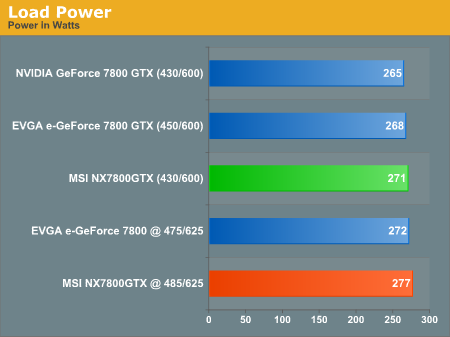Vendor Cards: MSI NX7800GTX
by Derek Wilson & Josh Venning on July 24, 2005 10:54 PM EST- Posted in
- GPUs
Heat, Power and Noise
We measured heat, power, and noise the same way that we did with the EVGA e-GeForce 7800 GTX, by looping a Battlefield 2 time demo for about 45 minutes to stress the system.Heat

An interesting thing that we noticed about this card is that it runs a lot cooler than the EVGA. We attained an idle temperature of 40 degrees Celius as opposed to EVGA's 46° C, and when we started running tests, our suspicions were confirmed. Clocked normally, the MSI NX7800 GTX reached a peak temperature of 75° C, and only went up by one degree when we overclocked it. EVGA's temperature was 81° C for both the 475MHz and 450MHz clock speeds, which is a significant difference. This might be the card to go with if you live in an extremely hot area as it seems to handle its heat pretty well. Of course, heat can vary as much as the ability to overclock in every card, so it could simply be a case of the MSI board having a "sweeter" chip.
Power
We measured power at the wall outlet in the different states as described in the last article to get an idea of how much of a power load the card uses.

While the system was idle, we observed that the power load was 147 watts, which is about 6 watts more than the system with the EVGA card. Although the temperature of this card was lower than EVGA's, it is odd that the card seemed to create a larger power draw on the computer. As the graph shows, at 430 MHz, the power load is 271 W, and overclocked to 485MHz, it's 277 W. EVGA's card had only 268 W at 450MHz, and 272 W at 475MHz.
Noise
As with the EVGA card, we didn't notice anything strange about the fan noise. It wasn't especially quiet or loud from a subjective standpoint compared to other 7800 GTX cards. We used the formula mentioned before and reached the end result of 39.2 dB. This is slightly higher than the EVGA card's noise level.For those interested, the formula looks like this (all sound measurements are made at a stationary position one meter from the system):
gpufactor = (10(SPLsys / 20))2 - (10 (SPLamb+cpu / 20))2SPLsys is the measured SPL of the entire system.
SPLamb+gpu = 20 log(sqrt(gpufactor + (10( SPLamb / 20))2))
SPLamb is the SPL of the room with the computer shut down.
SPLamb+ cpu is the measured SPL of the system without the graphics card installed.
Since the heat sinks have been the same so far, it's no surprise that there isn't much difference in noise levels. Likely, there will not be much of a difference between future cards, except if we see things like varying fan speeds or, of course, different styles of heat sinks.










42 Comments
View All Comments
DerekWilson - Monday, July 25, 2005 - link
Actually, Chronicles of Riddick can stress the card too. It's also a really good game.If the choice is just between BF2 and Riddick and you already have BF2 I would *definitely* suggest Riddick.
Nothing beats $500 for the 450MHz card with BF2 right now though.
arswihart - Sunday, July 24, 2005 - link
dumb sticker